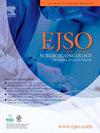Model to predict postoperative complications after hepatectomy based on comprehensive complication index: A retrospective multicenter study
IF 2.9
2区 医学
Q2 ONCOLOGY
引用次数: 0
Abstract
Background
Postoperative complications following hepatectomy are often complex and involve multiple systems. This study aims to employ the Comprehensive Complication Index (CCI) to thoroughly assess postoperative complications, identify patients at high risk for severe complications, and inform preoperative management and preventive strategies.
Methods
In this retrospective study, we evaluated all adverse events within 30 days post-hepatectomy. Each complication was individually assessed, and CCI scores were calculated based on the Clavien-Dindo Classification (CDC) system. Short-term outcomes were analyzed for all patients to identify predictors of severe complications.
Results
A total of 1350 cases were analyzed, with 21 types of complications recorded, resulting in an overall complication rate of 46.61 %. Patients in the high CCI score group experienced significantly longer postoperative and total hospital stays. Independent risk factors identified included prolonged postoperative hospital stay, increased total intraoperative output, elevated postoperative blood creatinine levels, and preoperative pulmonary comorbidities. Conversely, a higher postoperative neutrophil ratio and red blood cell count were protective factors. Two surgical teams were associated with worse postoperative CCI outcomes. The nomogram model developed in this study demonstrated strong predictive performance, with an area under the ROC curve of 0.844 (95 % CI: 0.814–0.874), a sensitivity of 86.9 %, and a specificity of 65.4 %. The model estimated a 9.36 % risk of severe complications in patients with a total score of 36.
Conclusions
The predictive model developed in this study effectively identifies high-risk patients for severe complications after hepatectomy. This tool can guide perioperative preventive measures and early interventions to improve patient outcomes.
基于综合并发症指数的肝切除术术后并发症预测模型:一项回顾性多中心研究
背景:肝切除术后的并发症通常是复杂的,涉及多个系统。本研究旨在通过综合并发症指数(CCI)全面评估术后并发症,识别严重并发症高危患者,为术前管理和预防提供依据。方法在这项回顾性研究中,我们评估肝切除术后30天内的所有不良事件。对每种并发症进行单独评估,并根据Clavien-Dindo分级(CDC)系统计算CCI评分。对所有患者的短期预后进行分析,以确定严重并发症的预测因素。结果共分析1350例,记录21种并发症,总并发症发生率为46.61%。CCI评分高组患者术后住院时间和总住院时间明显延长。确定的独立危险因素包括术后住院时间延长、术中总输出量增加、术后血肌酐水平升高和术前肺部合并症。相反,术后较高的中性粒细胞比例和红细胞计数是保护因素。两个手术小组与较差的术后CCI结果相关。本研究建立的nomogram模型具有较强的预测能力,其ROC曲线下面积为0.844 (95% CI: 0.814-0.874),敏感性为86.9%,特异性为65.4%。该模型估计,总分为36分的患者发生严重并发症的风险为9.36%。结论本研究建立的预测模型能有效识别肝切除术后严重并发症的高危患者。该工具可以指导围手术期预防措施和早期干预措施,以改善患者预后。
本文章由计算机程序翻译,如有差异,请以英文原文为准。
求助全文
约1分钟内获得全文
求助全文
来源期刊

Ejso
医学-外科
CiteScore
6.40
自引率
2.60%
发文量
1148
审稿时长
41 days
期刊介绍:
JSO - European Journal of Surgical Oncology ("the Journal of Cancer Surgery") is the Official Journal of the European Society of Surgical Oncology and BASO ~ the Association for Cancer Surgery.
The EJSO aims to advance surgical oncology research and practice through the publication of original research articles, review articles, editorials, debates and correspondence.
 求助内容:
求助内容: 应助结果提醒方式:
应助结果提醒方式:


